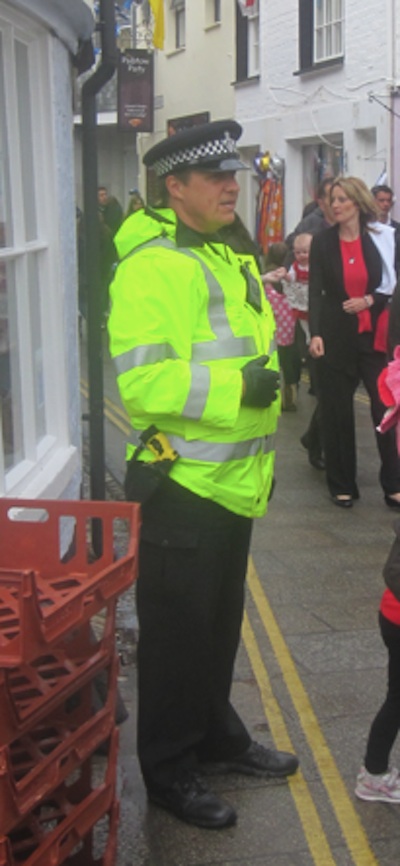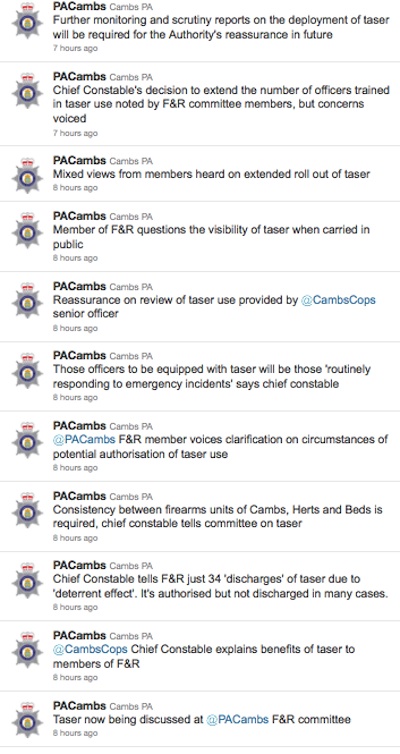
Further details of Cambridgeshire Police’s plans to expand TASER deployment have been published. The Chief Constable intends to train one hundred and twenty non-firearms officers to use the weapons. That’s just over one in ten of the force’s 1011 constables.
A paper from Cambridgeshire Police’s Chief Constable to Cambridgeshire Police Authority’s Finance and Resources Committee on the 18th of January 2012 was published at just after 16.00 on the 11th of January accompanied by a press release / news article posted on the authority website:
- TASER – Future Intentions (PDF) – Meeting Paper
- Authority members to discuss extended use of tasers – Press Release
The discussion at the police authority has been rendered rather pointless as Cambridgeshire’s Chief Constable stated he would overrule the police authority if they oppose his proposals when they were briefly discussed at the December 2011 full authority meeting.
My Comments on the Report
A key omission from report by the Chief Constable is the lack of any discussion of the potential impact on police-public relations and on the public’s perceptions of the police force. I think this is an important consideration; it is the reason the Metropolitan Police Authority have refused TASER deployment to all frontline police in London, their rejection was based on: “the potential to cause fear and damage public confidence”. Policing in the UK is something done using relatively few officers, we have a thin blue line, and to maintain that state of affairs the police need to have good relations with the public.
Another surprising omission from the report is evidence from what has happened in similar forces where non-firearms officers have been issued with TASER weapons. The report does not, for example, detail how non-firearms officers have been using the weapons in Bedfordshire and Hertfordshire; it does not say how much, if at all, TASER used increased in those forces when non-firearms officers were given the weapons and what proportion of TASER use in those areas is now by non-firearms officers.
The Chief Constable (or his officers) have not discussed their intentions in public at the many local police consultative meetings which are regularly held around the force area. The proposal was not for example mentioned at the last West/Central Area Committee where councillors and the public discussed policing central Cambridge. When the force last considered expanding TASER use they said they would do so following consultation. While a consultation with the decision already made isn’t ideal at least some communication and conversation with the public could have been carried out.
There are hints that as a result of the decision the number of TASER uses in Cambridgeshire would be expected to rise. The report says that under the current system where Authorised Firearms Officers only have TASER weapons there were: “many more incidents where TASER may have been authorised if not limited by the availability of AFOs”.
The report is unclear on if TASERs will be routinely carried by officers on patrol or when responding to calls. The report does state that: “The requirement to authorise TASER will remain the same as that for existing firearms officers”, but lacks the information on if the weapons will be routinely carried. If the weapons were routinely carried officers would as I understand it be free to “self-authorise”. Unlike other forces Cambridgeshire Police does not proactively publish its firearms policies.
The company which makes the TASERs used by the UK police advises against shooting people in the chest with them. The Chief Constable’s report doesn’t say if this advice is to be passed to the officers in Cambridgeshire who are to be trained to use the weapons.
The Chief Constable’s report states the non fire-arms officers who are to be given TASER weapons are to be given: “An initial 3 day course followed by half day public order input”. The force has previously argued that the TASER training is entirely separate from firearms training. My view is that there are clear overlaps in terms of making a decision on what level of force is appropriate to use in a particular situation. The Chief Constable states that the non-firearms officers will be less confident handling TASERs than those who have been firearms trained so he appears to an extent at least to agree with this. The “public order input” aspect concerns me. In December 2010 the Home Affairs Select Committee heard clear assurances from the police and home office officials that TASER should not, and will not, be used for crowd control in public order situations.
The main driving force for the proposed change appears to be the closer collaboration between Cambridgeshire Police and the Hertfordshire and Bedfordshire forces. A combined Armed Response Unit is to be in place from April 2012, Cambridgeshire doesn’t want to be calling on, and paying for, this unit to attend incidents which only require TASER.
Speaking at the December full authority meeting the Chief Constable worryingly stated that where TASERs were carried the public would probably not notice, raising the question of if they are to be carried in an intentionally concealed manner. This aspect too has not been addressed in the report, though authority members were offered the opportunity to have an officer attend the committee meeting to demonstrate how the weapons will be carried.
At the December full authority meeting the Chief Constable suggested that the reason non-firearms officers had TASER in Hertfordshire was that officers had demanded them after one of their number was stabbed. My view is that while we should listen to the views of officers they ought not be the only consideration when setting police policy.
Cambridgeshire Police is working ever more closely with Hertfordshire and Bedfordshire forces, and bringing the policies in line is another related element of the argument for the deployment of the weapons in Cambridgeshire.
Impact on Armed Policing Unit
If the Armed Policing Unit are not dealing with lower level incidents will they suffer from less experience in resolving situations and determining the appropriate level of force?
If the Armed Policing Unit isn’t available to deal with incidents requiring a TASER, is it available quickly enough for incidents where it is required. Is this issue actually pointing to a problem with insufficient firearms police coverage following the merger of the service?
Monitoring
The Police Authority committee is invited to: “Discuss the appropriate level of monitoring of the extension of the availability of TASER”. I think the police should be as open and transparent as possible about how and when TASER is used:
- Reports on TASER usage should be typed up so they are legible.
- Statistics on TASER use by non-firearms officers, including details of how many times an individual was TASERed, and for how long, ought be routinely published and reviewed by the Police Authority
- Outcomes of complaints about TASER use ought be openly published (suitably anonymised if required).
- Details of incidents where TASERs ought be published (suitably anonymised) in a timely manner after they occur.
This of course won’t happen as the police are very secretive, police complaints are dealt with in secret, and it wouldn’t really make sense to bring these things in just for non-firearms officers’ use of TASER, they ought be introduced more widely.
See Also
Recent TASER articles
- Large Rise in UK Police TASER Use – December 2011
- My article reporting Chief Constable Simon Parr to expand the force’s TASER use – December 2011.
- Cambs Chief Constable Would Overrule Police Authority on TASER Deployment – December 2011
Older Articles
- Opposing More UK Police being Armed with TASERs – Letter to my MP, David Howarth, September 2007.
- All UK Front Line Response Police to Carry TASERs – My article following the November 2008 announcement by the Home Secretary.
- Cambridgeshire Police Authority – December 2008 – First discussion of TASERs by Cambridgeshire Police Authority following the Home Secretary’s Announcement.
- The Role of Police Authorities in Decisions to Extend TASER Deployment
- Encouraging Liberal Democrats to Act Locally on their National TASER Policies – February 2009
- Cambridgeshire Police Authority Dodge my TASER Questions – May 2009
- TASERs for Non-Firearms Police – includes tables showing the number of TASERs for non-firearms officers distributed to forces.
- Cambridgeshire Police Worst In Country for Accidental TASER Discharges
- Non-Firearms Officers Account for a Third of TASER Usage
- Me discussing the TASER rollout to non-firearms officers with James Whale on LBC radio.
- Home Affairs Select Committee Session on TASERs – December 2010.
- Prodding the Home Office to Resume Publishing Statistics on TASER use by the Police January 2011
6 responses to “120 Non-Firearms Officers to be TASER Trained in Cambridgeshire”
As I understand it Tasers will not be carried as shown in the picture but in a black pouch closed top and bottom. The officer would have to undo the velcro closure and reach in for the Taser. Not sure if this is right so will want to hear from the police.
The Chief Constable certainly suggested they would be concealed at the December meeting of the police authority, but his report to the upcoming committee doesn’t address the question.
Richard, thanks for highlighting this. It seems very undemocratic that the chief constable is prepared to ignore the Police Authority’s caution and issue TASERs against their wishes. We all agree that PCs should be properly equipped to deal with emerging situations, but this is too much. I sincerely believe that the issue of TASERs will escalate violence against police officers and resuld in the death of an innocent person.
The ‘public order’ input is likely to focus around a taser trained officer supporting a police shield team entering a building to arrest a dangerous offender. As said it is very unlikely they would be used in a large scale public order situation.
My views are that policing is an increasingly dangerous job and taser is a valuable tool to gain compliance and protect officers and the public. What are the alternatives when a person is so dangerous and un-compliant? baton gun or live firearm?
The Oxford Street stabbing shows what happens if you give Tasers away without adequate training – an officer tasers onlookers to get them to move back.
To my eyes if he had done it for any longer there could have been a surge in the crowd in a very constrained area causing injury
http://www.dailymail.co.uk/news/article-2078925/Oxford-Street-stabbing-Police-brandish-Taser-bystander-try-regain-control-crowd.html
The police authority met, but only noted the Chief Constable’s report. I think this shows them, and the authority to be useless, pointless and supine.
The committee ought to have identified the areas where the report was lacking; clarified them, and worked towards being able to put the question of the policy change to a meeting of the full authority which could then take a decision.
The authority tweeted from the meeting:
